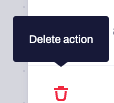This article describes automatically creating a new approval task on a signed contract. It contains the following topics:
- Video tutorial
- Creating a new automation
- Setting up the automation trigger
- Setting up the automation action
- Using parties and signees across automations
- Setting up the task due date
- Deleting an automation action
- Renaming the automation
- Making changes to a published automation
- Using the automation activity feed
- Testing the automation workflow
- Fixing a failed automation
- Checking the automation workflow
How to automatically notify the relevant approver as soon as a contract is signed?
- With the help of the in-app automation builder, you can customize and centralize the entire approval flow for all contracts generated from a specific template.
- If you are new to the in-app automation builder, click here to access our simple step-by-step guides for adding approval flows.
- Here is a short video tutorial of the needed for the automation steps:
How to set up approval automation in-app?
Click on Automations tab from the main menu and then on the blue button Create new at the upper right-hand corner.
How can I configure the trigger event?
- You will be redirected to a pop-up window where you can customize the automation's setup.
- The first thing you need to do is set the trigger event for the automation to be executed.
- To begin with, select the Contract is signed trigger from the drop-down menu. This will automatically open a configuration window to the right in which you can define which contract should start the automation.
- You can assign the trigger to every contract, only contracts drafted from a specific template or only a specific contract.
- We recommend using "Every contract drafted from a specific template" for the most efficient automation flow.
- This will allow you to automatically assign a new approval task to the relevant assignee each time you have signed a contract from a specific template by turning it into a draft first:

- After selecting one of the three main options, you can use the search bar to find the particular contract, draft, or template you want to base the automation flow on by name.
- If you have several documents sharing the same name, you can click on the small eye icon to directly open the particular document allowing you to review it.
- After choosing the correct file, you can proceed with choosing which signature should start the automation.
- This extra configuration enables you to pick whether the trigger of the automation should be executed after each time a signee completes a signature added to the contract (Every signature) or only after the last signature that defines the contract as fully signed is completed (Final signature):

- Use the drop-down list to select the option to define whether adding a new approval task to the signed contract should happen automatically after each signature or only after the last one.
- In our use case, we will choose the Final signature option under the automation setup and expect all required signatures to be added first for the signed contract to be automatically assigned with the configured approval task:

- After completing the trigger event configuration, you can confirm all customizations by clicking on Save, and the next step in the automation setup will be displayed.
How can I delete the trigger in the automation builder?
At the bottom of each trigger configuration window, you can delete only this specific trigger and not the complete automation:

How can I configure the action event?
This adjustment step covers the action the automation trigger you have just defined will generate. You can use the search bar to locate the option Request approval:

- A new configuration window will appear on the right side of the screen.
- Here you can customize the approval task properties by defining assignees, followers, title and description of the task, due date, and reminders:

- The first detail in the automation action configuration is the Document ID of the template, which will be used to start the automation.
- It will be automatically fetched and available in the required field at the top of the Request approval window:

- The following configuration steps allow you to deeply customize the task by writing a title and description by combining text input and data fields from your template.
- For our example, we have configured the following task to be added to each signed "Employment contract":

- Directly below the approval's description, you can block the document from signing until the assignee completes the task, if applicable.
- In our case, the flow is based on an already signed contract, eliminating the need for this checkbox to be checked off:

- In the following configuration step, you will have the ability to invite assignees and followers by email or by searching for a contact variable associated with them on a contract level:

How do I use party or signee variables in my automation?
❗️Important: You can always use any party or signee variable when adding variables to the title, description, assignees, or followers of your new approval task.
This can deliver essential details to the task's stakeholders fetched directly from the associated with any signee information.
Can I use a date from the document as the task's due date?
- You can choose Manual or based on automation variable and choose any data field with Date type as the due date of the automatically created renewal task.
- You can then select to use this date or set a specific offset.
- Usually, approval tasks will use the execution time as a due date, while renewal tasks will be based on a data point in the contract.
Next, in the next block of the task configuration window, you can set a due date for its completion. There are two available options for the date type in the drop-down menu:

- In the example we are configuring, we will use the first option of a date type: manual or based on automation variable. The chosen value will be the exact start date assigned to an employment contract in the editable fields sharing that name.
- After the date type, you can configure the due date by using the date defined in the previous step or offset (before or after), which is entirely customizable.

The last task property you will be allowed to configure will be the alerts reminding you of the due date.
The date type can be again based either on a due date or an automation variable. You can set as many alerts as needed, such as our example, which includes two notifications:

- The first alert we have chosen is based on the start date data field filled in as a unique data point on a signed contract.
- And the following alert is based on the task's due date - we have identified the reminder to go on one week before the due date.
- All attributes dictating how the reminders will be run are entirely customizable.
- Once you have everything done, click Save to confirm the configuration of the approval task and then Publish in the upper right-hand corner.
How can I delete an action in the automation builder?
At the very bottom of each action configuration window, you have the option to delete only this specific action and not the complete automation:

How can I rename the automation?
You can always rename the automation and its steps as you find fit by clicking on the small pen icon next to the generic title in the upper left-hand corner. In the example we are working with, we will call it "Approval automation - Employment contract":

How can I make changes to published automation?
Note: If at one point you need to make any changes to the automation flow, remember to unpublish it first, then make the needed edits and click again on Publish to put the flow into practice. You can control that by turning the Status toggle bar on or off:

How can I use the activity feed of my automation?
If you click on the three grey dots next to the status toggle bar, you can open, rename, delete, or see the activity feed of the automation.
❗️Important: Remember that the automation must be active (published) for the activities to be available to you.
This option allows you full traceability of the automation's usage and flow:

In the activity sidebar, you can see all the details of when the automation was used and the steps taken before it was triggered.
Just click on the small arrow next to the date and time to expand the details:

In addition, you will always be notified in-app in the Notifications at the top navigation bar as soon as any of your automation flows has been executed:

Note: You can adjust the email and in-app notifications under Profile Settings for your account.
How can I test the published approval automation?
For the test to be performed, you can just add yourself as a signee, then first save the template as a new draft, turn it into a contract by sending it to yourself, and sign it. Remember to choose Only me as the signature method at the top of the draft. You will then be able to fully sign the draft only by adding your signature.
As soon as the contract has been signed, go to your documents overview and check the notifications under your account. The status of the automation will be listed there as either successful or failed.
How can I fix a failed automation?
In case the automation has failed, you can access the detailed view by clicking on the failed notification in the list under your profile notifications:

In this view, you can identify the reason for the failure by expanding the failure to run details. You can then use the information found here to change the approval automation back from the configuration settings.

How can I check the automation runs successfully?
If your approval automation has run successfully, you can open the signed contract created from the template you have defined in the automation flow.
There should be automatically assigned in the task sidebar view approval task with the same properties as the ones you have chosen under the configuration of your automation.

Using the functionalities of the Contractbook task sidebar view, you can amend any changes to the created approval task, including marking it as resolved.
❗️Important: you can only mark a task as completed if you are assigned to it.

- Of course, you can also find the task in the general tasks management dashboard, which allows you to adjust the task's properties and directly access the document it is assigned to.
- As usual, you will also be able to see that there has been a new pending task in the documents view when locating the signed contract created from the template chosen for the automation flow:

Now that you have tested the automation workflow, you can use it actively and save time by assigning the approval tasks to the relevant individuals.
With our in-app automation builder, you ensure that you always meet that deadline.
If you still need additional information or assistance, contact us anytime by contacting our Support Team.
